子供のための砂漠の動物たちを写真と事実で紹介します。 砂漠に住む動物のA to Zリスト。
- はじめに。 砂漠 & 砂漠の動物
- 砂漠の動物の適応
- 砂漠の動物ワークシートの無料ダウンロード
- Discover amazing animals that live in other habitats
- A To Z List Of Desert Animals
- Addax
- Antelope Jackrabbit
- Arabian Oryx / White Oryx
- アラビアンサンドガゼル/リーム
- キャメルスパイダー
- デスストーカー・スコーピオン
- Desert Iguana
- デザートトータス
- Dromedary
- フェネックギツネ
- Greater Flamingo
- Gila Monster
- Golden Hamster
- Jerboas
- キタキツネ
- Lappet-Faced Vulture
- ミーアキャット
- Mulgara
- Namib Desert Beetle / Fogstand Beetle
- オナガ
- Saharan Silver Ant
- サンドキャット / 砂丘猫
- Sandgrouse
- Sidewinder
- Southern Marsupial Mole
- Tarantula Hawk Wasp
- Thorny Devil
- Water-Holding Frog
- 野生のラクダ
- Desert Animals For Kids: Conclusion
- Discover Amazing Animals From Other habitats …
- Become an Animal Expert with Active Wild …
はじめに。 砂漠 & 砂漠の動物
(下にスクロールして動物を見てください!)
砂漠は、ほとんど雨が降らない地域です。
砂漠は、非常に暑いか、非常に寒いかのどちらかになる傾向があります。
砂漠の動物は通常、水不足と極端な気温の両方に対処するための特別な適応を持っています。
世界で最も暑い場所の多くは砂漠です。 しかし、すべての砂漠が暑いわけではありません。
北極や南極は雨(雪)がほとんど降らないので、砂漠とみなされます。
これらの極地は「冷たい砂漠」として知られています。 極地にすむ動物については、こちらのページで紹介しています。
下のリストにある動物はすべて、アフリカのサハラ砂漠やカラハリ砂漠、北米のソノラ砂漠やモハベ砂漠、オーストラリアの大ビクトリア砂漠、中東のアラビア砂漠などの「暑い砂漠」に住んでいます。
- 砂漠の植物の一覧は、こちらからご覧になれます。
- 砂漠の植物については、「砂漠の植物とその写真と実情」をご覧ください。
砂漠の動物の適応

砂漠に住む動物に見られる適応は、体温を放散する大きな耳、水を蓄える能力、ごくわずかな水で生き抜く能力、夜間の生活、穴蔵の生活などが挙げられます。
多くの砂漠は、日中は非常に暑いにもかかわらず、夜間は非常に寒くなる。
砂漠の動物ワークシートの無料ダウンロード

FREE desert animals pdf worksheet: Click image to download. このページで使用する印刷可能な質問シートを、こちらから無料でダウンロードすることができます。 (会員登録不要、ダウンロードして印刷するだけです。)詳しくはこちらをご覧ください。 印刷用ワークシート(無料)をご覧ください。
Discover amazing animals that live in other habitats
- Rainforest Animals List with Pictures & Facts
- Arctic Animals List with Pictures & Facts
- Antarctic Animals List with Pictures & Facts
- Ocean Animals List with Pictures & Facts
- Australian Animals List with Pictures & Facts
- African Animals List with Pictures & Facts
A To Z List Of Desert Animals
A to Z list of desert animals with pictures and facts about each species. Links to further information are provided for many of the animals.
Addax
- Scientific name: Addax nasomaculatus
- Type of animal: 哺乳類、偶蹄目
- 発見された場所。 サハラ砂漠
- 保全状況。
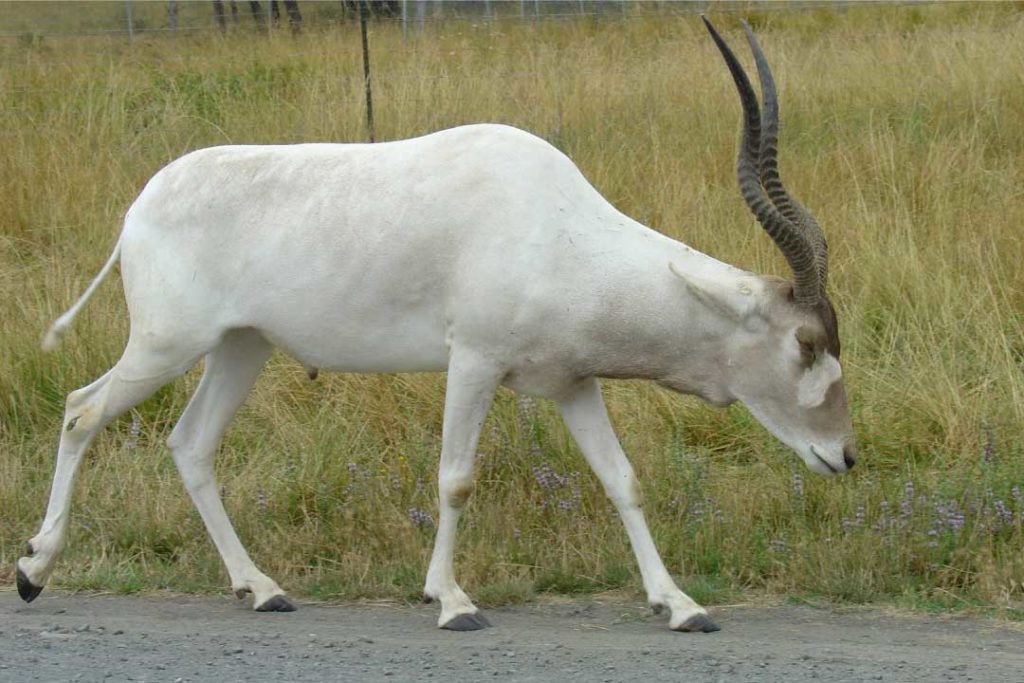
アダックスはサハラ砂漠で見つかったカモシカの危機的な種である。
アダックスの主な脅威は、密猟である。
アダムの伝統的な生息地の多くが農地に転用され、生息地の喪失もこの種の絶滅寸前の状態に一役買っています。
アダムの成体は、野生では90頭以下、おそらく30頭ほどしか残っていないと考えられています。
Antelope Jackrabbit
- 学名: Lepus alleni
- 動物の種類:Antelope Jackrabbit。 哺乳類、Leporidae科(ウサギ科)
- 発見された場所。 アリゾナ州ソノラン砂漠 & メキシコ北部
- 保護状態。 Least Concern

The antelope jackrabbit is a hare found in deserts and other dry habitats in the south western United States. It is one of the largest North American hares.
The species can be identified by its large size, very long, pointed ears, white / gray sides, white underparts, buff neck and chest, and black / buff back.
The diet of this herbivorous mammal includes cacti and mesquite leaves. (Mesquite is a small tree that grows in deserts and other dry habitats.)
Arabian Oryx / White Oryx
- Scientific name: Oryx leucoryx
- Type of animal: Mammal, Even-toed ungulate
- Where found: Arabian Desert
- Conservation status: Vulnerable

The Arabian oryx is the smallest of the four antelopes in the genus oryx.
アラビアンオリックスは、1970年代初頭に野生で絶滅してしまった。 1990年代から始まった再導入計画では、飼育されていた個体を野生に戻した。
最大の脅威は違法な狩猟です。
アラビアンサンドガゼル/リーム
- 学名:Gazella marica
- 種類:動物。 Mammal, Even-toed ungulate
- Where found: シリア砂漠、アラビア砂漠
- 保全状況。 Vulnerable
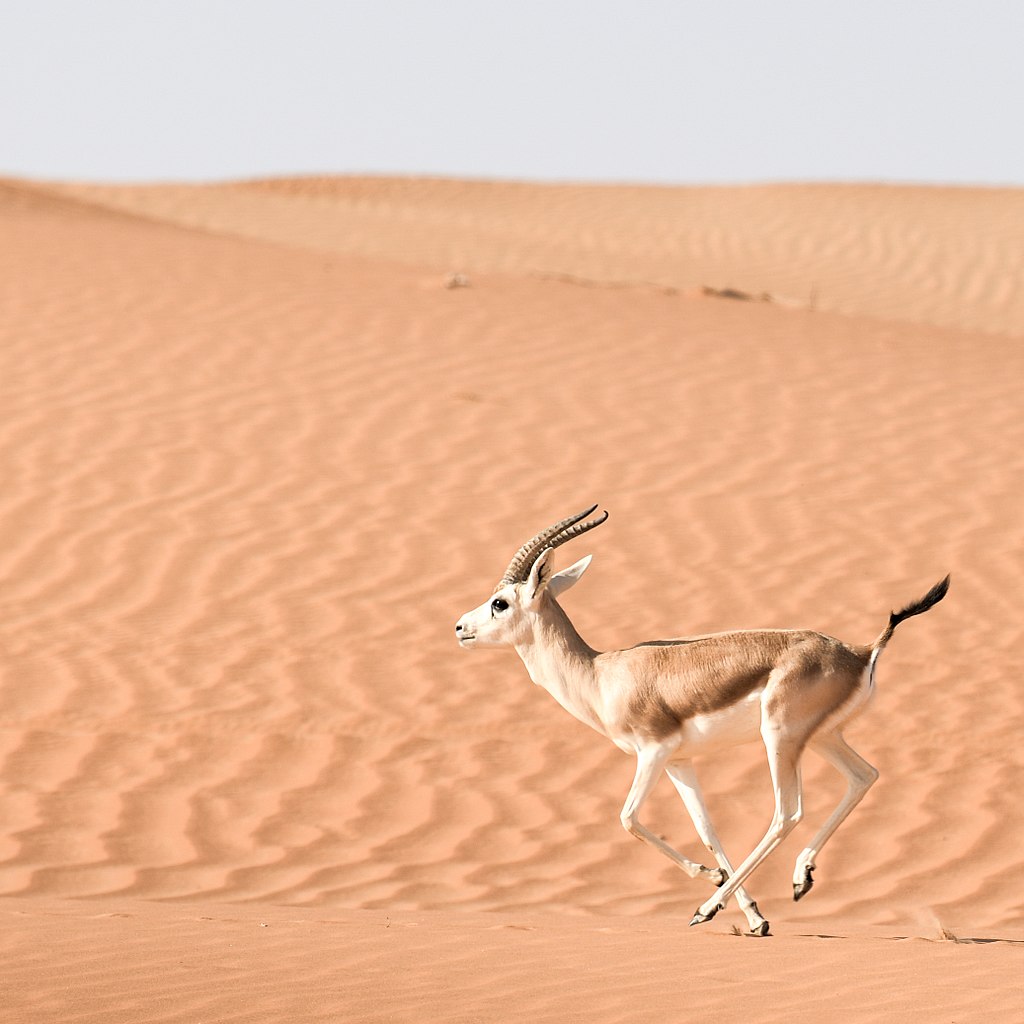
Photo: AhmedAlAwadhi7 アラビアンサンドガゼル(別名「リーム」)は小さなアンテロープです。
砂漠の専門家であるアラビアン・サンド・ガゼルは、かつてアラビア半島全域に生息していた。
砂漠に特化した動物で、かつてはアラビア半島全域に生息していたが、現在はほとんどの個体が保護区にいる。
現在、IUCN(国際自然保護連合)の評価では、Vulnerable(危急危険)種である。
キャメルスパイダー
- 動物の種類。 クモ形類、Solifugae目
- 発見された場所。
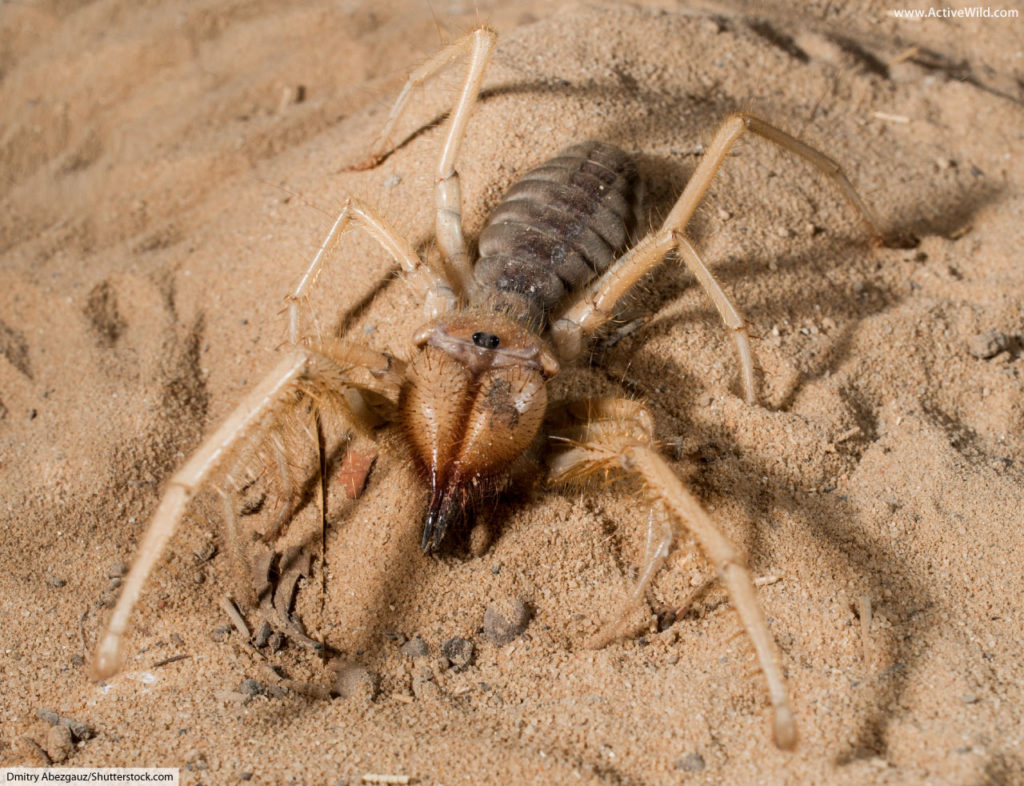
Camel spiders are most often found in desert habitats. Camel spider are arachnid in the order Solifugae…砂漠に住む蜘蛛。 (
ラクダグモの多くは、その大きく強力な口部によって識別することができます。
すべてのラクダグモには4対の脚があり、さらに「前脚」と呼ばれる1対の脚のような構造があり、感知と摂食に使われます。
仲間のクモ類であるクモと違い、ラクダグモは絹を作れず、網を張りません。
1000以上の種が存在するラクダグモです。 大きさは数ミリから15センチ(脚を含む)ほど。
- ラクダグモについては、こちらで詳しく紹介しています。 Camel Spider Facts
デスストーカー・スコーピオン
- 学名:Leiurus quinquestriatus
- 動物の種類:Deathstalker Scorpion
- 学名:Leiurus quinquestriatus
- 動物の種類は? クモ形類、サソリ
- 発見された場所。 サハラ砂漠、アラビア砂漠
- 保全状況:なし
- You can find out more about scorpions here: Scorpion Facts
- Scientific name: Dipsosaurus dorsalis
- Type of animal: 爬虫類、鱗翅目
- 発見された場所。 Sonoran Desert, モハベ砂漠
- 保全状況。 Least Concern
- 学名:Gopherus agassizii
- 動物の種類:Desert Tortoise。 爬虫類、Testudines目
- どこで発見されました。 Mojave Desert
- Conservation status:
- You can find out more about the Mojave desert tortoise here: Mojave Desert Tortoise Facts
- Scientific name: Camelus dromedarius
- Type of animal: Mammal, order Artiodactyla (the even-toed ungulates)
- Where found: Sahara Desert
- Conservation status: Domestic animal
- 学名: Vulpes zerd
- 動物の種類: 哺乳類、食肉目
- 発見された場所。 Sahara Desert
- Conservation status:
- You can find out more about this animal here: Fennec Fox Facts
- Scientific name: Phoenicopterus roseus
- Type of animal: Bird, family Phoenicopteridae
- Where found: Kalahari Desert
- Conservation status: Least Concern
- この種についてもっと知るには、こちらへどうぞ。
- 学名: Heloderma suspectum
- 動物の種類:Glater Flamingo。 Reptile, order Squamata
- Where found: ソノラン砂漠
- 保全状況。
- ギラ・モンスターに噛まれると痛いですが、ほとんどの健康な人間にとっては、命にかかわることではありません
- ギラ・モンスターについてもっと知ることができます。 Gila Monster Facts
Golden Hamster
- Scientific name: Mesocricetus auratus
- Type of animal: Mammal, order Rodentia (rodent)
- Where found: Syrian Desert
- Conservation status: Vulnerable

Pet hamsters are descended from wild desert animals. The golden hamster is a rodent found in the wild in Syria and Turkey (the animal is also known as the Syrian hamster).
Although a popular pet in many parts of the world, the wild population of golden hamsters is decreasing, and the species’ conservation status is Vulnerable.
Golden hamsters are territorial, and do not tolerate other hamsters in their territories. Hamsters are able to carry large amounts of food in the cheek pouches – useful if they come across more food than they are able to eat in one sitting.
Jerboas
- Type of animal: 哺乳類、齧歯目、双子葉動物科
- どこで発見されたか。

Photo: Николай Усик / http://paradoxusik.livejournal.com/ ダーボアは双弓類に属するネズミの一種である。
カンガルーと同じように、ホッピングで移動する。 後肢は長く力強く、前肢は短い。 長い尻尾は、飛び跳ねるときや直立するときにバランスを保つのに役立つ。
砂漠で生活するために、いくつかの工夫がされています。 カモフラージュのための砂色の被毛や、穴蔵での生活などです。
キタキツネ
- 学名: Vulpes macrotis
- 種類: 動物。 哺乳類、食肉目
- どこで発見された。 ソノラン砂漠
- 保全状況。

キットフォックスはアメリカ南西部とメキシコ北部に生息する小型のイヌ科動物である。
この種は大きな耳で知られており、優れた聴覚と体温を下げる手段の両方を備えている。
また、砂漠での生活に適応するために、足の裏には毛が密生しているのも特徴です。
キタキツネはほとんど水を飲まない。 Instead they get most of the water they require from their almost completely carnivorous diet.
A nocturnal, burrowing lifestyle helps them avoid the highest desert temperatures.
Lappet-Faced Vulture
- Scientific name: Torgos tracheliotos
- Type of animal: Bird, order Accipitriformes
- Where found: Desert areas of Africa and the Middle East
- Conservation status: Endangered

Photo: Yathin sk The lappet-faced vulture is a large bird of prey found in Africa and the Middle East. It has a bald, pink / red head and a powerful bill, which is almost 4 in. (10 cm) long and 2 in. (5 cm) deep.
ほとんどのハゲワシと同様に、主にスカベンジャーであるが、ハゲタカは時々生きている獲物を狩ると考えられている。
巨大な嘴で、かたい皮膚や腱、骨も切り裂くことができる。
ミーアキャット
- 学名: Suricata suricatta
- 動物の種類: ミーアキャット
- 学名: Suricata suricatta
- 動物の種類: ミーアキャット。 哺乳類、食肉目
- どこで発見されました。 カラハリ砂漠、ナミブ砂漠
- 保全状況。 Least Concern
動物の種類: ミーアキャット

ミーアキャットはマングース科ヘルペス属の哺乳類であります。 砂漠やサバンナ、草原などの乾燥した環境に生息している。
この特徴的な砂漠の動物は、最大50匹からなる群れで生活しています。
この特徴的な砂漠の動物は、最大50匹からなる群れで生活しており、日中は活動し、夜は大きな穴の中で過ごします。
- ミーアキャットについては、こちらのページで詳しく解説しています。
Mulgara
- 学名:Brush-tailed mulgara。 Dasycercus blythi; Crest-tailed mulgara: Dasycercus cristicauda
- 動物の種類。 哺乳類、有袋類
- 発見された場所。 Great Sandy Desert
- 保全状況。 Brush-tailed mulgara: Least Concern; Crest-tailed mulgara:

Cest tailed mulgara Mulgarasはオーストラリア中央部の砂漠地帯で見つかったラットサイズの有袋類である。 ブラッシュテイルマルガラとクレストテイルマルガラの2種があります。
タスマニアデビルやクオールと同じDasyuridae科である。
どちらも肉食で、主に小さな爬虫類や昆虫、げっ歯類などを食べる。
このオーストラリアの砂漠の動物は、ほとんど水を飲まず、腎臓は水を保存するために特別に適応しているのだそうです。
Namib Desert Beetle / Fogstand Beetle
- Scientific name: Stenocara gracilipes
- Type of animal: Insect, order Coleoptera (beetles)
- Where found: ナミブ砂漠
- 保全状況。

アフリカ南部の海岸砂漠であるナミブ砂漠に生息する昆虫です。
この虫は、特殊な翅のケースを使って、早朝の霧の中から小さな水滴を集め、それが虫の背中から口へと流れ込むのです。
この砂漠の昆虫の集水能力は注目されています。発明家たちは、同様の方法で空気中から水を集める材料や製品の開発に取り組んでいます!
オナガ
- 学名: Equus hemionus
- 動物の種類: オナガザル
- の仲間。 哺乳類、奇蹄目
- 発見された場所。 ゴビ砂漠、アジアの他の乾燥した生息地
- 保全状況。

Photo: Gideon Pisanty (Gidip) גדו5DF↩ פיזנטי Asian wild assとも呼ばれるオンナは、馬科の哺乳類で、ひづめがあり、哺乳類としては世界一です。
この種には、モンゴル野牛、トルクメニア野牛、ペルシャ野牛、インド野牛の4つの亜種が存在する。 モンゴル野牛、トルクメニア野牛、ペルシャ野牛、インド野牛である。
オナガザルは、世界最速の哺乳類の一種です。
オナガガエルは、世界最速の哺乳類の 1 つです。 両生類、目Anura(カエルとヒキガエル)
- 見つかった場所。 モハベ砂漠
- 保全状況。 Least Concern

This small toad is found in deserts and other dry habitats in the southwestern United States and northern Mexico. It reaches lengths of around 3 inches (7.6cm), and has pale olive green skin marked with black patches and smaller red spots.
The red-spotted toad spends much of its time sheltering from the sun in rocky crevices near streams. It is most often seen during periods of rainfall, when it emerges from its hiding place.
Saharan Silver Ant
- Scientific name: Cataglyphis bombycina
- Type of animal: Insect, family Formicidae (the ant family)
- Where found: Sahara Desert
- Conservation status: Unassessed

Photo: Bjørn Christian Tørissen このアフリカの砂漠のアリが銀色に見えるのは、体にある小さな毛が、砂漠の熱い太陽を反射して虫が過熱しないよう特別な適応をしているためである。
サハラ砂漠のアリは他にも、長い脚で熱い砂から体を遠ざけ、6本の脚のうち4本だけで歩き、砂との接触面積を最小限に抑えるなど、砂漠で生活するための工夫をしています。
サンドキャット / 砂丘猫
- 学名: Felis margarita
- 動物の種類: 砂丘猫(Sand Dune Cat)。 哺乳類、食肉目、ネコ科
- 発見された場所。 サハラ砂漠、アラビア砂漠
- 保全状況。 Least Concern

The sand cat is a rarely-seen desert cat found in northern Africa and the Middle East. It is smaller than a domestic cat, and has pale, sandy-colored hair, which is often marked with darker spots or stripes.
A layer of thick fur on the sand cat’s paws provides protection from the hot desert sand.
The sand cat has large, pointed ears, and is thought to have hearing that is far more acute than that of a domestic cat.
The sand cat is usually either nocturnal or crepuscular (active at dawn or dusk). It is only active during the day in the coolest months of the year.
Sandgrouse
- Type of animal: Birds in the family Pteroclidae
- Where found: Desert regions of Africa & Asia

Photo: Mike Prince from Bangalore, India Sandgrouses are birds in the family Pteroclidae. Most of the 16 members of this family are found either in deserts or other dry habitats.
These medium-sized, ground-dwelling birds are seed-eaters. Sandgrouses often congregate in large numbers around waterholes then disperse to forage for seeds either alone or in smaller groups.
Sidewinder
- Scientific name: Crotalus cerastes
- Type of animal: Reptile, order Squamata
- Where found: Mojave Desert & other regions of SW United States and NW Mexico
- Conservation status: Least Concern
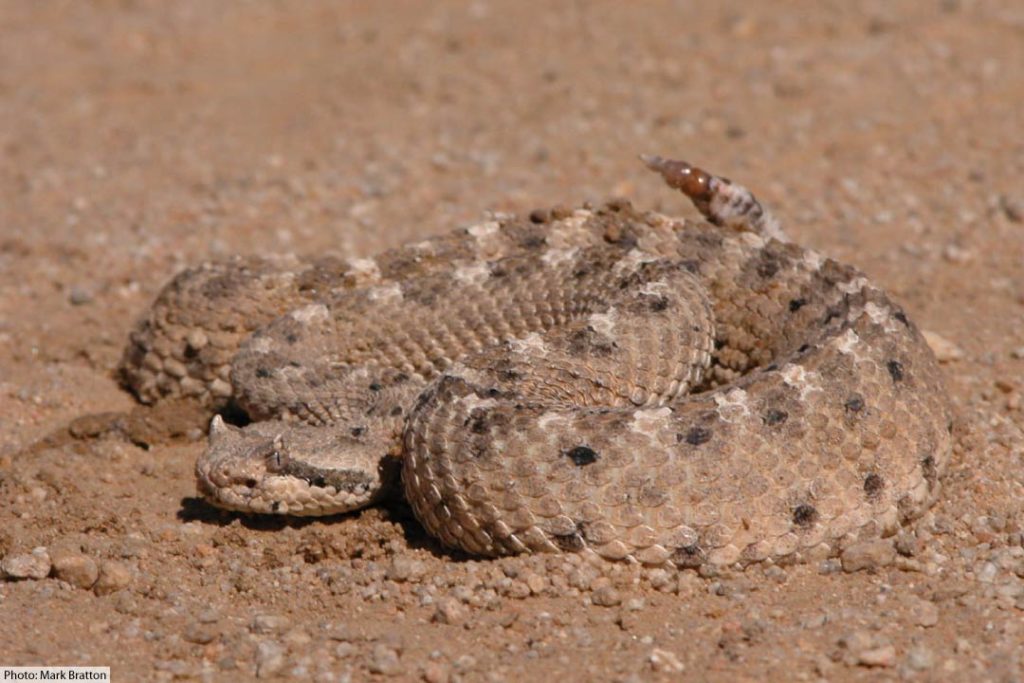
The sidewinder is a species of rattlesnake that inhabits desert regions in California, Nevada, Utah and Arizona.
この種の名前は、尾を固定し、頭を前に押し出し、尾を前に引き、それを繰り返すことによって、砂の上を高速で移動することができる、その移動方法に由来しています。
この移動方法は他の砂漠のヘビも行っており、サイドワインディングと呼ばれる。
サイドワインダーは、目の上に突き出た角のような鱗から、ホーンテッド・ラトルスネークとしても知られている。
サイドワインダーは毒を持つ。噛まれると非常に痛いが、生命を脅かすことはほとんどない。
- この種についてもっと知るには、ここをクリックしてください。 Sidewinder Facts
Southern Marsupial Mole
- Scientific name: Notoryctes typhlops
- Type of animal.Of.Pirates
- 科学的な名前:Notoryctes typhlops
- 動物の種類。 哺乳類、有袋類
- 発見された場所。 Great Victorian Desert
- 保全状況。
- 学名:Pepsis grossa / Pepsis formosa(その他Pepsis属、Hemipepsis属)
- 種類:クモバチ科の虫
- 発生場所:浙江省杭州市、浙江省杭州市、浙江省杭州市、浙江省杭州市。
- 保全状況:未評価
- Scientific name: Moloch horridus
- Type of animal: Reptile, order Squamata
- Where found: Great Victorian Desert
- Conservation status: Least Concern
- トカゲは、一晩で体についた露を飲むことができるのです。 Thorny Devil Facts
- Scientific name: Cyclorana platycephala
- Type of animal.Odyssey: Cyclorana platycephala
- 水棲のカエル。 両生類、目Anura(カエルとヒキガエル)
- 見つかった場所。 Great Victorian Desert
- 保全状況。 Least Concern
- 学名:Camelus ferus
- 動物の種類:Bactrian Camel(バクトリアンキャメル)。 哺乳類、偶蹄目
- どこで発見された。 ゴビ砂漠
- 保全状況。
- You can find out more about the wild Bactrian camel here: Wild Bactrian Camel Facts
- Rainforest Animals List with Pictures & Facts
- Arctic Animals List with Pictures & Facts
- Antarctic Animals List with Pictures & Facts
- Ocean Animals List with Pictures & Facts
- Australian Animals List with Pictures & Facts
- African Animals List with Pictures & Facts
- Animals: The Ultimate Guide to the Animal Kingdom
- A to Z Animals with Pictures & Facts
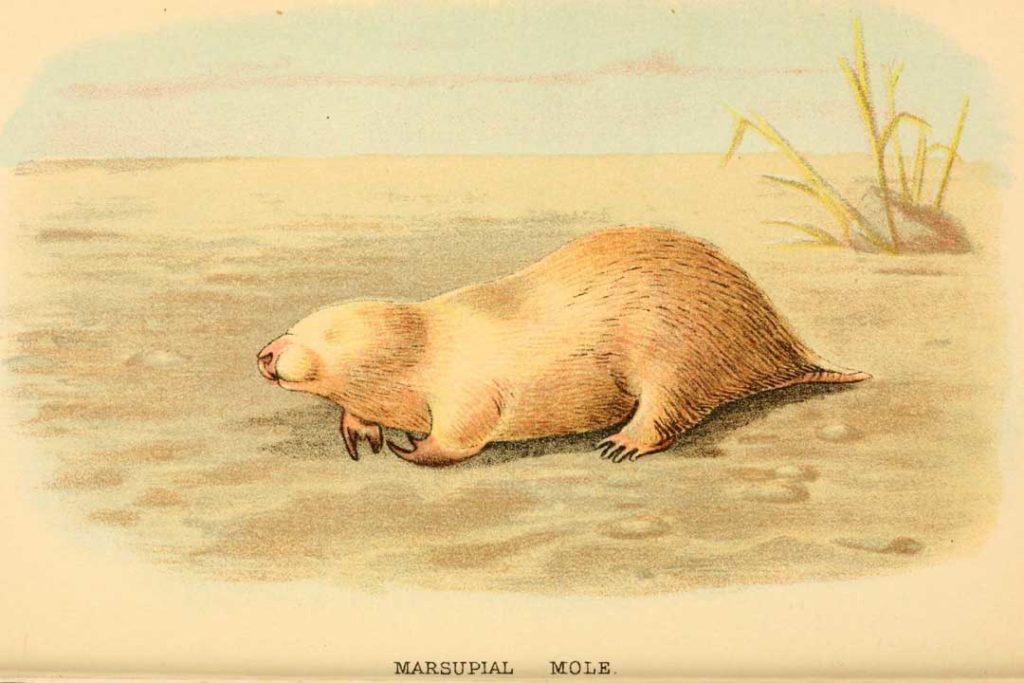
収斂進化とは、異なる種類の動物が同じ種類の生活様式を持つことによって、同じような特徴や能力を持つようになることです。
オーストラリアの砂漠地帯に生息するモグラは、収斂進化の一例で、見た目も行動もモグラによく似ていますが、有袋類なので、名前の由来となった動物とは非常に遠い関係にあります。
オーストラリア内陸部の高温乾燥地帯に生息し、地下のトンネルでミミズなどの無脊椎動物を狩って生活している。
Tarantula Hawk Wasp

タランチュラ・ホークスープはペプシス属の大型バチです。
タランチュラ・ホークスープの最も知られているものの一つがペプシス・グロッサという種です。
タランチュラ・ハスバチの刺し傷は、昆虫界では悪名高い弾丸アリに次いで2番目に痛いと言われています。
虫刺されの評価尺度であるシュミット刺痛指数では、痛みレベルが4(最高得点)です。
ペプシス・グロッサは、アメリカ南部とメキシコに生息しています。 It uses its powerful sting to hunt tarantula spiders.
The tarantula hawk wasp is the state insect of New Mexico.
Thorny Devil

トゲウオオトカゲは、オーストラリア中央部から西部のほとんどの乾燥地帯で見られる小さなトカゲです。 体や手足はトゲで覆われている。 頭の後ろには「デコイヘッド」と呼ばれる、2本の大きな角が生えた肉質の突起があります。
トカゲの皮膚には小さな溝があり、水を直接口に運ぶことができる。
Water-Holding Frog

Photo: en:User:Tnarg 12345 ホールドウェルはオーストラリアの中央部の乾燥地帯で見つかった砂漠性の両生類である。
アマガエル科に属しながら、地上で生活しています。
実際、この種は一生の大半を1メートルも地中に埋まり、マユに包まれて過ごします。
乾季になると、水棲カエルは休眠することができるようになります。
乾燥した時期には、水棲カエルは休眠することができます。休眠は冬眠に似た状態で、エネルギーを節約するためにカエルは活動しなくなります。
野生のラクダ

John Hill 野生のバクトリアラクダは絶滅の危機にある砂漠性の動物であります。
どちらも2つのこぶを持っていますが、野生のラクダの方がより小さいです。
野生のラクダは、海水よりも塩分の高い水にも耐えられるといわれています。 中国のロプノール野生ラクダ国立自然保護区には約600頭が生息しています。 Around 350 live in the Great Gobi A Strictly Protected Area in Mongolia. Their numbers are decreasing.
Desert Animals For Kids: Conclusion
We hope that you have enjoyed meeting these desert animals. What is your favorite desert species? Have you seen any of these animals in the wild? Are there any other desert animals you think should be on this list?
Let us know in the comments below; we’d love to hear your views!
Discover Amazing Animals From Other habitats …
Become an Animal Expert with Active Wild …
Visit these pages to learn more about animals and the animal kingdom:

Photo: מינוזיג The deathstalker is one desert animal you probably don’t want to stumble upon. Its venom is among the most powerful of all scorpions’. A sting from this fearsome arachnid is extremely painful and potentially fatal.
The deathstalker inhabits desert and scrubland habitat in North Africa and Western Asia. It is around 6 cm in length, and appears in a variety of colors and markings, making it hard to identify.
The deathstalker isn’t all bad news; its venom can be used to locate tumors in the human body.
Desert Iguana

The desert iguana is found in the southwestern USA and northern Mexico.
この地域の砂漠で最もよく遭遇するトカゲの1つです。 (
体長は尾を含めて24インチ(60cm)ほどで、体長の1.5倍ほどである。
砂漠のイグアナは、気温が高いときでも日中は活動的である。
デザートトータス

今日、デザートリクガメは、近縁のソノラ砂漠のカメGopherus morafkaiと区別するためにモハーヴェ砂漠のカメとしても知られています。
It was only in 2011 that the tortoises were separated into two species; until then both had been known as the desert tortoise.
The Mojave Desert tortoise is present to the north and west of the Colorado River in California, Nevada, Utah and Arizona. This shy reptile is rarely encountered; it spends up to 95% of its time in burrows, or hidden in rock shelters.
The Mojave Desert tortoise digs its own burrows, and will hibernate underground during the winter.
Dromedary
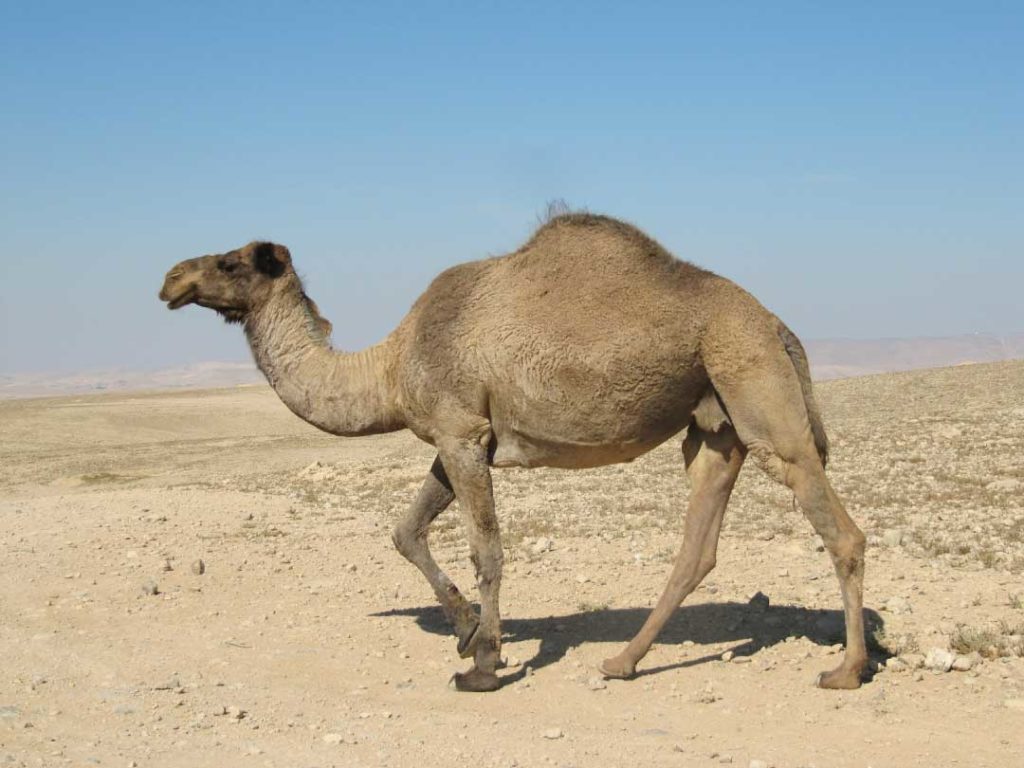
Camels are among the most famous of all desert animals. この蹄鉄を持つ哺乳類は、多くの砂漠地帯でよく見られる動物で、約4000年前に家畜化されました。
ラクダには、一腹駱駝、二腹駱駝、野駱駝の3種がいる。
ドロメダリーはラクダ全体の94%を占め、圧倒的に多い。 現在では家畜として、砂漠地帯で最もよく見られる動物です。
オーストラリアには、人間によって持ち込まれた動物の子孫からなる小さな野生のドロメダリーが生息しています。
ドロメダリーは、砂漠で生活するために、ふさふさの眉毛、二重になったまつ毛、完全に閉じることのできる鼻の穴など、多くの適応能力を持っている。
フェネックギツネ
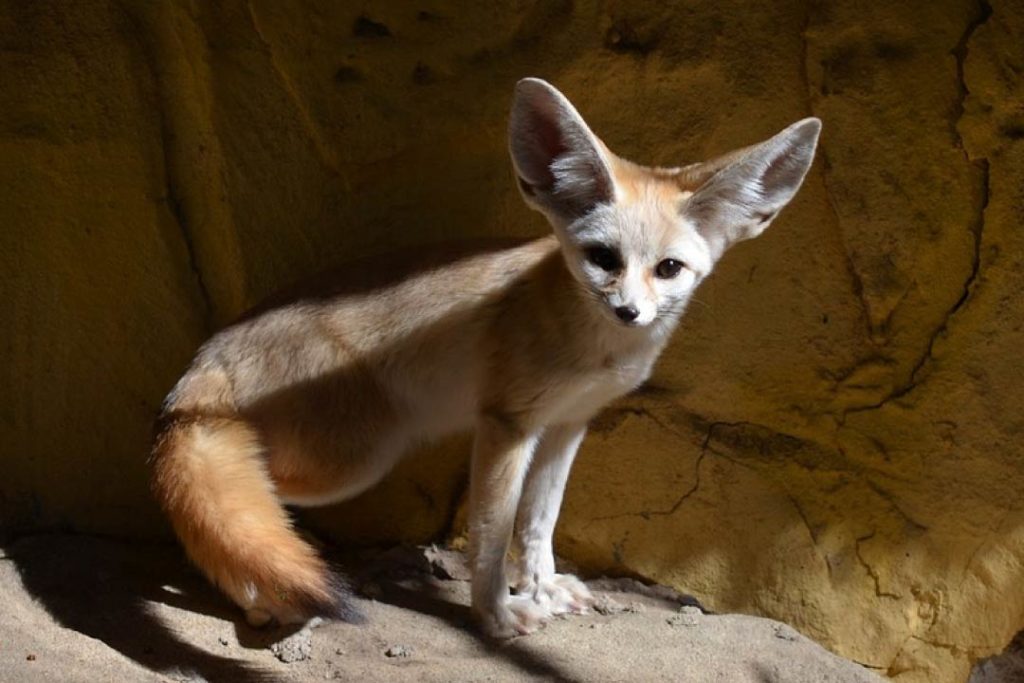
北アフリカや中東に分布する哺乳類です。 また、「萌黄色」とも呼ばれる。 (
フェネックギツネは、その特徴的な長い耳で知られており、その長さは15cmにも及びます。
フェネックギツネの前足には厚い毛が生えていて、グリップと熱砂からの保護を提供する。 This keeps the fox warm at night, when temperatures in the Sahara Desert can be surprisingly low, even (occasionally) dropping below 0 °C.
Greater Flamingo

Greater flamingo (Phoenicopterus roseus) The greater flamingo is the largest of the six species of flamingo, and one of only two found outside of the Americas.
この大きくて淡いピンク色の鳥は、アフリカ、アジア、ヨーロッパの浅い湖、ラグーン、河口で見られます。
砂漠だけの動物ではありませんが、オオフラミンゴは砂漠地域の浅い湖や氾濫原を訪れます。
毎年、何千ものオオフラミンゴが、ボツワナの北東部のマクガディガディ・パンに、繁殖目的で訪れています。
Gila Monster
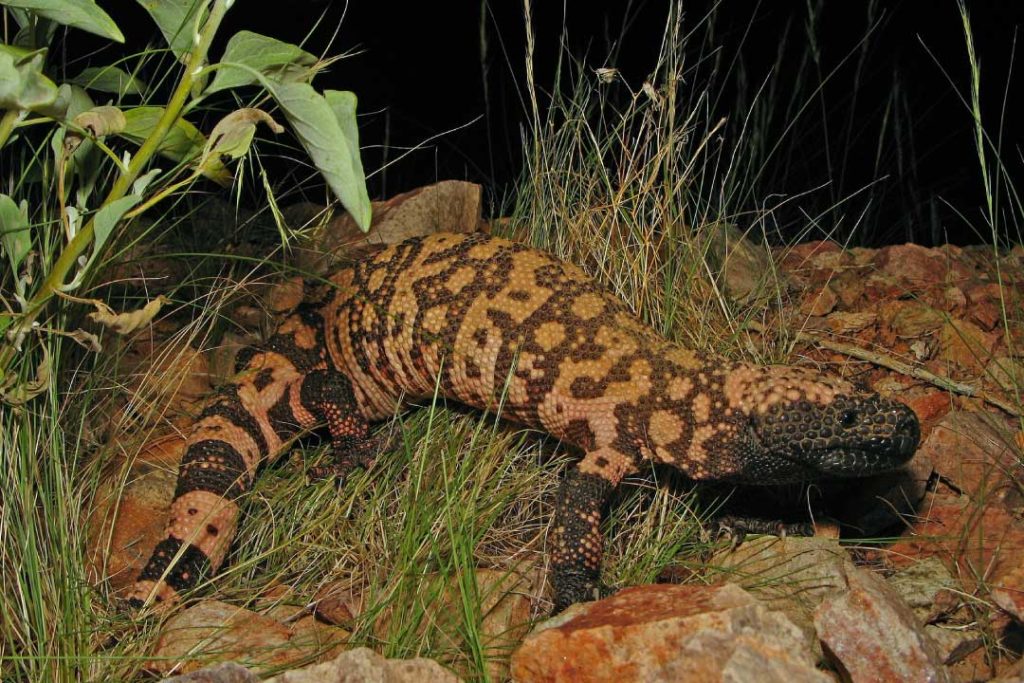
アメリカ南西部とメキシコ北部の乾燥した生息地に生息するトカゲであり、その名前はGila Monster。 比較的大きく、動きの遅いトカゲである。
ギラ・モンスターは、アメリカ大陸に生息する2匹の毒トカゲのうちの1匹です(もう1匹は、近縁種のメキシコビードトカゲです)。